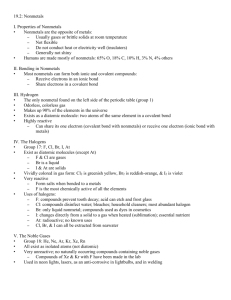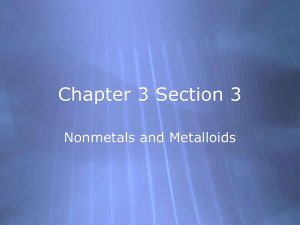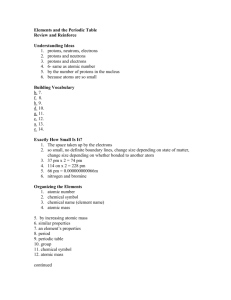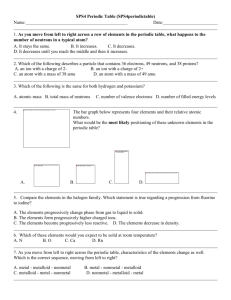The Metalloids
advertisement
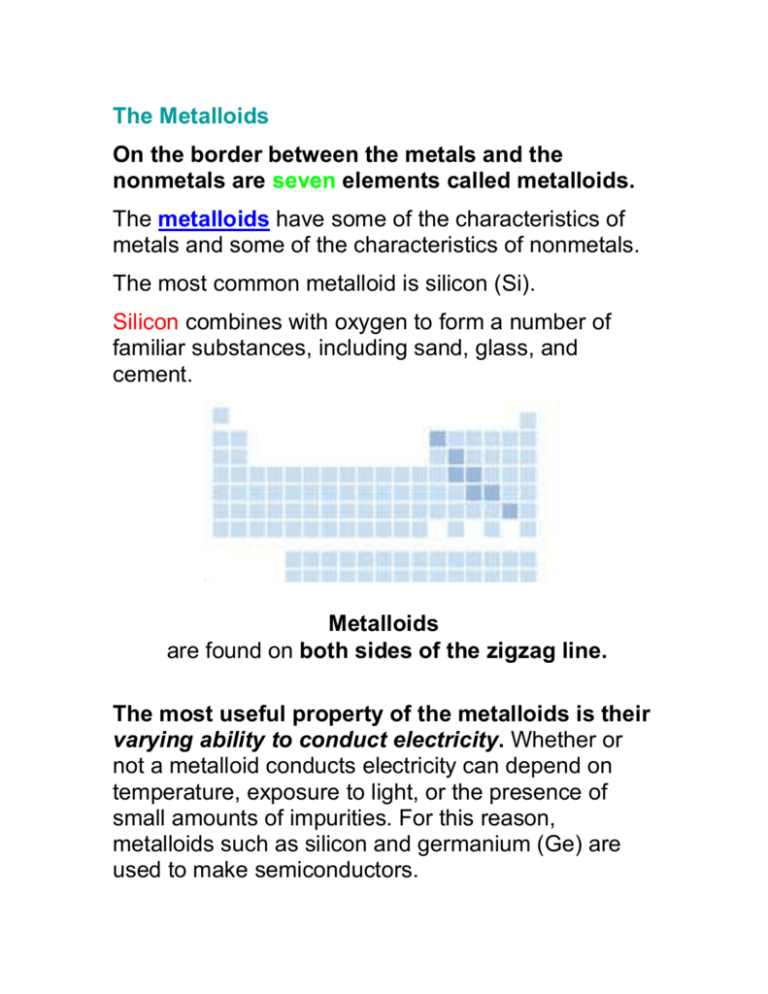
The Metalloids On the border between the metals and the nonmetals are seven elements called metalloids. The metalloids have some of the characteristics of metals and some of the characteristics of nonmetals. The most common metalloid is silicon (Si). Silicon combines with oxygen to form a number of familiar substances, including sand, glass, and cement. Metalloids are found on both sides of the zigzag line. The most useful property of the metalloids is their varying ability to conduct electricity. Whether or not a metalloid conducts electricity can depend on temperature, exposure to light, or the presence of small amounts of impurities. For this reason, metalloids such as silicon and germanium (Ge) are used to make semiconductors. Semiconductors are substances that under some conditions can carry electricity, like a metal, while under other conditions cannot carry electricity, like a nonmetal. Semiconductors are used to make computer chips, transistors, and lasers. What Is a Nonmetal? Nonmetals are the elements that lack most of the properties of metals. The nonmetals are located to the right of the zigzag line in the periodic table. nonmetals are very common elements extremely important to all living things on Earth. Physical Properties are gases at room temperature this means they have low boiling points. The air you breathe is made mostly of two nonmetals, nitrogen (N) and oxygen (O). Exceptions to gases are: Other nonmetal elements, such as carbon (C) and iodine (I), are solids at room temperature. Bromine (Br) is the only nonmetal that is liquid at room temperature. In general, the physical properties of nonmetals are opposite to those that characterize the metals. Nonmetals are: dull, unlike shiny metals. brittle, meaning they are not malleable and not ductile. they break easily or crumble into a powder (pencil lead—made of graphite) usually have lower densities than metals also poor conductors of heat and electricity. Chemical Properties Most nonmetals usually form compounds. **But the Group 18 elements hardly ever do. The difference has to do with valence electrons. Atoms of the Group 18 elements do not gain, lose, or share electrons. WHY? THEY ARE FULL AT 8 valence electrons. For this reason, the Group 18 elements do not react with other elements. The rest of the nonmetals have atoms that can gain or share electrons. In either case, the atoms of these nonmetals can react with other atoms, leading to the formation of compounds. Compounds of Nonmetals When nonmetals and metals react, valence electrons move from the metal atoms to the nonmetal atoms. Group 17 elements react easily this way. For example, common table salt (NaCl) is formed from sodium (Na) and chlorine (Cl). Sodium and Chlorine When the metal sodium reacts with the nonmetal chlorine, a valence electron is transferred from each sodium atom to a chlorine atom. Rust is a compound made of iron and oxygen (Fe2O3). It's the reddish, flaky coating you might see on an old piece of steel or an iron nail. Nonmetals can also form compounds with other nonmetals. The atoms share electrons and become bonded together into molecules, such as carbon monoxide (CO) and carbon dioxide (CO2). diatomic molecules nonmetals that form molecules of two identical atoms Examples of diatomic molecules are oxygen (O2), nitrogen (N2), and hydrogen (H2). Diatomic Hydrogen When two identical atoms of a nonmetal react, they share electrons Families of Nonmetals Look at the periodic table and notice the groups that contain nonmetals. Only Group 18 contains nonmetals exclusively. Other groups, such as Groups 14 and 15, contain three classes of elements: nonmetals, metals, and a third class of elements called metalloids. For this reason, the elements in Groups 14 and 15 are not as similar to one another as are elements in other groups. The Carbon Family Group 14 is also known as the carbon family. Each element in the carbon family has atoms with 4 valence electrons. Only one of the elements is a nonmetal, and that element is carbon itself. (The next two elements, silicon and germanium, are metalloids. Tin and lead are metals.) What makes carbon especially important is its role in the chemistry of life. All living things contain compounds that are made of long chains of carbon atoms. The Carbon Farmily and the Nitrogen Family Charcoal is composed mostly of the element carbon. Farmers provide their growing plants with fertilizers that include the element nitrogen. Applying Concepts Which has the greater mass, an atom of carbon or an atom of nitrogen? How can you tell? The Nitrogen Family Group 15, the nitrogen family, contains elements that have 5 valence electrons in their atoms. The two nonmetals in the family are nitrogen and phosphorus. To introduce yourself to nitrogen, take a deep breath. The atmosphere is almost 80 percent nitrogen gas. Nitrogen (N2) gas does not readily react with other elements, however, so you breathe out as much nitrogen as you breathe in. Living things do use nitrogen, but most living things are unable to use the nitrogen gas in the air. Only certain kinds of bacteria—tiny, microscopic creatures—are able to combine the nitrogen in the air with other elements, a process called nitrogen fixation. Plants can then take up the nitrogen compounds formed in the soil by the bacteria. Phosphorus is the other nonmetal in the nitrogen family. Unlike nitrogen, phosphorus is not stable as an element. So, phosphorus in nature is always found in compounds. Phosphorus is used to make matches and flares partly because it is so reactive. The Oxygen Family Group 16, the oxygen family, contains elements that have 6 valence electrons in their atoms. An atom in Group 16 typically gains or shares 2 electrons when it reacts. The three nonmetals in the oxygen family are oxygen, sulfur, and a rarer element named selenium. The Oxygen Family The making of modern rubber depends on the element sulfur. Interpreting Diagrams Which element is above sulfur in the periodic table? You are using oxygen right now. With every breath, oxygen travels through your lungs and into your bloodstream, which distributes it all over your body. You could not live long without a steady supply of oxygen. The oxygen you breathe is a diatomic molecule (O2). In addition, oxygen sometimes forms a triatomic (threeatom) molecule, which is called ozone (O3). Ozone collects in a layer in the upper atmosphere, where it screens out harmful radiation from the sun. Oxygen is very reactive, and can combine with almost every other element. It also is the most abundant element in Earth's crust and the second most abundant element in the atmosphere. Sulfur is the other common nonmetal in the oxygen family. If you have ever smelled the odor of a rotten egg, then you are already familiar with the smell of many sulfur compounds. These compounds have a strong, unpleasant odor. You can also find sulfur in rubber bands, automobile tires, and many medicines. The Halogen Family Group 17 contains fluorine, chlorine, bromine, iodine, and astatine. It is also known as the halogen family. All but one of the halogens are nonmetals, and all share similar properties. A halogen atom has 7 valence electrons and typically gains or shares one electron when it reacts. All of the halogens are very reactive, and most of them are dangerous to humans. But many of the compounds that halogens form are also quite useful. Fluorine, the most reactive of all the nonmetals, is found in nonstick cookware and compounds that help prevent tooth decay. Chlorine is already familiar to you in one form— ordinary table salt is a compound of sodium and chlorine. Other salts of chlorine include calcium chloride, which is used to help melt snow. Bromine reacts with silver to form silver bromide, which is used in photographic film. The Halogen Family and the Noble Gases The halogen fluorine is found in the nonstick surface of some cookware. Fluorine is a very reactive element, unlike the noble gas neon in some brightly lit signs. Relating Cause and Effect What makes the element neon so stable? The Noble Gases The elements in Group 18 are known as the noble gases. In some cultures, “noble” individuals held a high rank and did not work or mix with “ordinary” people. The noble gases do not ordinarily form compounds with other elements. This is because atoms of noble gases do not gain, lose, or share their valence electrons. As a result, the noble gases are chemically very stable and unreactive. All the noble gases exist in Earth's atmosphere, but only in small amounts. Because of the stability and relative scarcity of the noble gases, most were not discovered until the late 1800s. Helium was discovered by a scientist who was studying not the atmosphere but the sun. Have you ever come in contact with a noble gas? You have if you have purchased a balloon filled with helium. Noble gases are also used in glowing electric lights. These lights are commonly called neon lights, even though they are often filled with argon, xenon, or other noble gases. Hydrogen Alone in the upper left corner of the periodic table is hydrogen. Hydrogen is the simplest element—usually each of its atoms contains only one proton and one electron. Because the chemical properties of hydrogen differ very much from those of the other elements, it really cannot be grouped into a family. Hydrogen The tiny atoms of the element hydrogen are very reactive. Although hydrogen makes up more than 90 percent of the atoms in the universe, it makes up only 1.0 percent of the mass of Earth's crust, oceans, and atmosphere. Hydrogen is rarely found on Earth as an element. Most of it is combined with oxygen in water. When an electric current is passed through water, bonds are broken and diatomic hydrogen (H2) gas molecules are formed.
